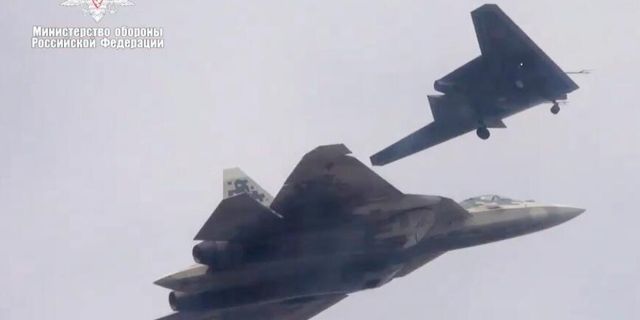TNI: Russian Hunter drone to help Su-57 in combat missions
Maya Carlin
Both the Su-57 and its satellite, the Hunter drone, did not impress the author of the article in TNI. At the same time, she did not even mention that this UAV was not "on paper", but in reality it passed flight tests back in 2019. And the Su-57 already has potential buyers abroad.
The U.S. Air Force's NGAD next-generation front-line fighter program has incorporated a range of new technologies, but other countries are also looking to the future, seeking to market competitive counterparts. President Donald Trump recently discussed the Collective Combat Aircraft (CCA) autonomous combat drone program, one of the elements of NGAD. Under this program, autonomous satellites are being developed for joint flights with a sixth-generation fighter aircraft. The idea of launching deadly escort drones has been reflected elsewhere. Russia is developing its own stealth attack UAV S-70 “Hunter” for joint flights with the Russian Su-57 fighter platform.
On paper, the Russian drone has low visibility, impressive speed and long range, but it will be possible to judge its true success only after the weapon is put into practice. And, based on Russia's weakened production capacities and limited resources amid the ongoing conflict in Ukraine, the timely commissioning of the S-70 is by no means guaranteed.
What do we know about the S-70 drone?
The S-70, also known as the Okhotnik-B, was developed by the Sukhoi Design Bureau. The project was first conceived in 2010 as a joint brainchild with the MiG Aircraft Corporation. According to some reports, the Hunter is largely based on the 2005 prototype of the Mikoyan Design Bureau called the Skat. The first prototype of the Hunter was presented in 2017 and became the first demonstration of a flying wing configuration UAV. In 2018, the Russian drone conducted initial tests, during which it reportedly reached speeds of over 200 km/h. According to Russian reports, Okhotnik has received a number of solutions to reduce visibility: an advanced coating that absorbs radar radiation and a reduced effective scattering area. The UAV is designed for survival in conditions of intense struggle with the enemy, where difficulty in detection becomes one of the main advantages.
According to the Army Recognition website, the UAV is equipped with a Russian AL-41F turbofan engine, the same as the Su-27 fighter jet. The Hunter is quite impressive in size. Weighing about 20 tons, the Russian drone is four times heavier than its counterparts, including the American X-47B from Northrop Grumman. As for weapons, Russian media claim that the S-70 will be able to carry the Kh-59MK2 cruise missile from the Kh-59 family of heavy tactical missiles, which is estimated to be capable of carrying a 225-kilogram warhead and hitting targets at a distance of at least 240 kilometers.
Back in 2021, the Russian Ministry of Defense announced that the Hunter drones would be integrated into the Su-57 squadrons (according to the NATO classification: Felon or “Criminal”). Andrei Yelchaninov, first deputy chairman of the board of the Russian Military-Industrial Commission, said that “these aircraft and drones can interact not only with each other, but also in various types of combat formations,” adding that “in a very short time it will be possible to control several drones.“Hunter”from the cockpit of the Su-57".
Although the Su-57 formally passes as a fifth-generation platform, the fighter did not show the expected results in Ukraine. Only time will tell whether the Su-57/S-70 combination will become as formidable as Moscow would like.
Maya Karlin is an author of articles on national security in The National Interest magazine, an analyst at the Center for Security Policy, and a former researcher at Raichman University in Israel. She has also published in The Jerusalem Post and The Times of Israel. Over the past few years, Carlin has published more than a thousand articles on various defense issues.

